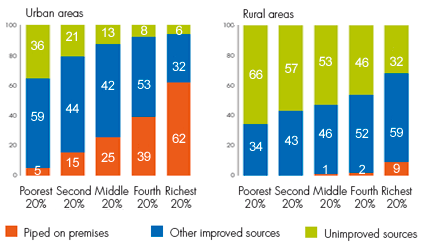- ON THE DECADE
- THE DECADE'S CAMPAIGN
- REPORTING ON PROGRESS
- THE DECADE'S PROGRAMMES
- FOCUS AREAS
-
- Access to sanitation
- Financing water
- Gender and water
- Human right to water
- Integrated Water Resources Management
- Transboundary waters
- Water and cities
- Water and energy
- Water and food security
- Water and sustainable development
- Water and the green economy
- Water cooperation
- Water quality
- Water scarcity
- FOCUS REGIONS
- RESOURCES FOR
- UN e-RESOURCES
Africa
Water's crucial role in accomplishing the continent's development goals is widely recognized. Africa faces endemic poverty, food insecurity and pervasive underdevelopment, with almost all countries lacking the human, economic and institutional capacities to effectively develop and manage their water resources sustainably. Thus, a large number of countries on the continent still face huge challenges in attempting to achieve the United Nations water-related Millennium Development Goals (MDGs) .
Access to water
Northern Africa and Sub-Saharan Africa even though in one continent, have made different levels of progress towards the Millennium Development Goal on water. North Africa has 92% coverage and is on track to meet its 94% target before 2015. However, Sub-Saharan Africa experiences a contrasting case with 40% of the 783 million people without access to an improved source of drinking water from the region. Sub-Saharan Africa is off track from meeting the MDG on water with just 61% water coverage and with the current pace cannot reach the 75% target set for the region.
An analysis of data from 35 countries in sub-Saharan Africa (representing 84% of the region’s population) shows significant differences between the poorest and richest fifths of the population in both rural and urban areas. Over 90% of the richest quintile in urban areas use improved water sources, and over 60% have piped water on premises. In rural areas, piped-in water is non-existent in the poorest 40% of households, and less than half of the population use any form of improved source of water.
Drinking water coverage by wealth quintiles, urban and rural residence, sub-Saharan Africa, based on population-weight averages from 35 countries (percentage).
Access to sanitation
Africa is one of the two major regions with the least improvement in accomplishing the MDG on sanitation by 2015. Despite the fact that North Africa has 90% coverage, Sub-Saharan Africa has a startling 30% coverage with only a 4% increase from 1990. This is a serious concern because of the associated massive health burden as many people who lack basic sanitation engage in unsanitary activities like open defecation, solid waste disposal and wastewater disposal. The practice of open defecation is the primary cause of faecal oral transmission of diseasewith children being the most vulnerable.
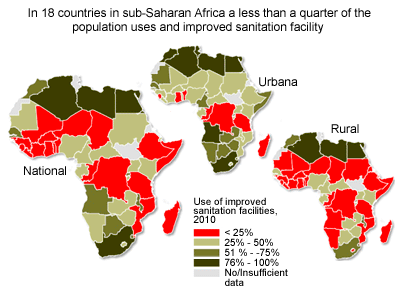
Source: A snapshot of Drinking Water and Sanitation in Africa-2012 Update. AMCOW, WHO/UNICEF JMP, 2012.
Africa as a whole, especially Sub-Saharan Africa despite efforts and approaches to extend and sustain water, sanitation and hygiene (WASH) systems and services has led to different health complications leading to death within the region. The water and sanitation position in West/Central Africa is of particular urgency, as the region has the highest under-five mortality rate of all developing regions: 191 child deaths per 1,000 live births. Recurrent outbreaks of cholera in both urban and rural areas underline the poor state of this region’s basic living conditions.
Driving forces and pressures
- Population growth and rural-urban migration
Africa’s rising population is driving demand for water and accelerating the degradation of water resources in many countries on the continent. Among developing regions, Sub-Saharan Africa is estimated to have the highest prevalence of urban slums and it is expected to double to around 400 million by 2020. Despite the efforts of some Sub-Saharan African countries and cities to expand basic services and improve urban housing conditions. Rapid and unplanned urban growth has increased the number of settlements on unstable, flood-prone, and high-risk land where phenomena such as landslides, rains, and earthquakes have devastating consequences.
- Economic development and poverty
Sub-Saharan Africa is the world’s poorest and least developed region, with half its population living on less than a dollar a day. About two-thirds of its countries rank among the lowest in the Human Development Index. Even when opportunities exist to address outstanding water issues, deep and widespread poverty across the African region constrains the ability of many cities and communities to provide proper water and sanitation services, sufficient water for economic activities and to prevent water quality from deteriorating.
Challenges, risks and uncertainties
- Finance and water management
Africa faces a situation of economic water scarcity, and current institutional, financial and human capacities for managing water are lacking. The situation is exacerbated by competition for public funding between sectors, and heavy public debt burdens in most countries.
In Africa, financing is insufficient and the institutional capacity to absorb what is available is limited. The danger of slippage to already made progress against the MDG on water and sanitation is real. Most countries within the continent are falling short to sustainWater Sanitation and Hygiene (WASH) commitments, with over 80% of countries reportedly falling significantly behind the trends required to meet their defined national access targets for sanitation and drinking-water. There is insufficient domestic financing for WASH overall with particularly serious shortfalls for sanitation. This is exacerbated by difficulties in spending the limited funds that are received.
- Lack of coordination
One other challenge Africa faces is lack of coordination among authorities, stemming from an unclear definition of roles and responsibilities, coupled with lack of harmonization of laws and policies related to environmental management. Inadequate staffing in government departments that handles environmental issues is another factor in the downward trend in environmental sustainability in some countries within the continent.
- Varied climate and natural hazards
Africa’s climate is characterized by extremes, from a humid equatorial climate at the equator, through tropical and semi-arid in the middle of the region, to an arid climate towards the northern and southern fringes. Sub-Saharan Africa has a relatively plentiful supply of rainwater, but it is highly seasonal, unevenly distributed across the region and there are frequent floods and droughts. Drought is the dominant climate risk in sub-Saharan Africa. It destroys economic livelihoods and farmers food sources and has a significant negative effect on Gross Domestic Product (GDP) growth in one-third of the countries.
Progress so far
In 2010, the share of the urban population with access to an improved water source ranged from 52% (Mauritania) to 100% (Egypt, Mauritius, Niger and Seychelles). The number of countries with at least 80% access to an improved water source in urban areas climbed from 26% in 1990 to 38% in 2010. In 2010, no country had a coverage rate of less than 50%, an improvement from four countries with less than 50% coverage in 1990. Coverage varied widely in 2010, from 7% in Somalia to 99% in Mauritius. The number of countries for which rural access was 80% or more rose from 5% in 1990 to 10% in 2010. Other good news was that the number of countries with less than 50% coverage fell from 27% to 16%.
Proportion of population using an improved sanitation facility is generally low – just 40% in 2010 and an increase of only 5 percentage points from 1990. As with improved drinking water supply, access to sanitation facilities shows a sharp contrast in urban and rural areas – in 2010, 54% and only 31%, respectively. However – again as with improved drinking water supply – urban areas actually recorded a decline in coverage from 1990’s 57%, and again this can be attributed to the high proportion of slum dwellers in a fast expanding urban population. Rural areas saw slight progress, up from 25% in 1990.
In 2011, African countries reported substantive political commitments to WASH, increasing funding allocations, and leadership and coordination among implementing agencies. The majorities of countries have established transparent WASH service provision targets and have put in place supporting policies, and many monitor against these targets. Countries also confirm that the rights to water and sanitation are increasingly adopted in laws or policies.
Several countries have also committed to meeting their commitments made under other initiatives; for instance, Ethiopia has developed a plan to meet its sanitation commitment in line with the eThekwini Declaration.The Africa Water Vision 2025 has been adopted by African governments, the New Partnership for Africa’s Development and the African Union. This is evidence of a new focus on water and, potentially, better-targeted investment and more efficient water management.
Did you know?
- Africa is the world´s second-driest continent after Australia.
- About 66% of Africa is arid or semi-arid and more than 300 of the 800 million people in sub-Saharan Africa live in a water-scarce environment – meaning that they have less than 1,000 m3 per capita per year.
- 115 people in Africa die every hour from diseases linked to poor sanitation, poor hygiene and contaminated water.
- 35% of Water and Sanitation aid commitment on MDG goes to Africa with Sub-Saharan having 27% of the financial allocation.
- In Africa, especially sub-Saharan Africa, more than a quarter of the population spends more than half an hour per round trip to collect water.
- Africa’s rising population is driving demand for water and accelerating the degradation of water resources. By mid-2011, Africa’s population (excluding the northern-most states) was around 838 million and its average natural rate of increase was 2.6% per year, compared to the world average of 1.2%. By one estimate its population will grow to 1,245 million by 2025 and to 2,069 million by 2050.
- The urban slum population in sub-Saharan African countries is expected to double to 400 million by 2020 if governments do not take immediate and radical action.
UN initiatives which are helping to raise the issue...
- Human values in Water, Sanitation and Hygiene Education Programme (HVWSHE)
UN-Habitat has implemented the HVWSHE programme, as part of the Water for African and Asian Cities Programmes, to impart information on water, sanitation and hygiene and also inspire and motivate learners to change their behaviour and adopt attitudes that promote hygienic living and wise and sustainable use of water. - Lake Victoria Region Water and Sanitation Initiative
In 2004, UN-Habitat, in association with the Governments of Kenya, Tanzania and Uganda launched a major initiative to address the water and sanitation needs of the population, particularly the poor, in the secondary urban centres around Lake Victoria. The Lake Victoria Region Water and Sanitation Initiative (LVWATSAN) is supporting participating governments to achieve the Millennium Development Goals for water supply and sanitation, with emphasis on innovative solutions and speedy delivery. - Water and Sanitation Trust Fund (WSTF)
The WSTF, which was established in 2003, aims to leverage new investment and ideas to expand the water and sanitation (WATSAN) service coverage for poor urban dwellers and help build momentum for achieving the Millennium Development Goals (MDGs) with a strategic plan for 2008-2012. - Water for African Cities
The Water for African Cities Programme, initiated in December 1999, facilitates the adoption of measures to ensure access to environmentally sound water and sanitation service provision to the unserved, as well as improved access for underserved populations of the target cities. Through demonstration projects and capacity building interventions carried out in collaboration with national partners, regional and international financial institutions, the programme supports water supply and sanitation utilities, local governments, NGOs and communities to leverage resources for scaling up and replication at the country level. - Water and Sanitation Program (WSP): Economic Sanitation Initiative-Africa
Launched in 2007, the WSP Economic Sanitation Initiative in Africa draws attention to how good sanitation policies and practices can underpin socio-economic development and environmental protection by an estimation of economic impacts on populations without access to improved sanitation in order to provide information on the losses to society of the current sanitation situation.
To know more
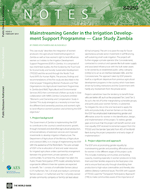 Mainstreaming Gender in the Irrigation Development Support Programme - Case Study Zambia
Mainstreaming Gender in the Irrigation Development Support Programme - Case Study Zambia
World Bank. February 2014
This case study describes the integration of women producers into agricultural investment programs in Zambia as well as how women’s right to land influences women as it relates to the Irrigation Development Support Programme (IDSP) in Zambia. The study discusses the projects aim to develop irrigated agricultural land managed by smallholders, including emergent farmers and making sufficient water available to support large-scale commercial operations. It is comprised of two interlinked studies, the first in the internal paper “Integrating Women Producers and Their Organizations into Agricultural Investment Programmes in Zambia (and Mali)” and a follow-up study entitled “Women’s Land Ownership and Compensation Study in Zambia.”
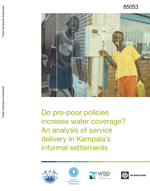 Do pro-poor policies increase water coverage? An analysis of service delivery in Kampala’s informal settlements
Do pro-poor policies increase water coverage? An analysis of service delivery in Kampala’s informal settlements
World Bank. January 2014
This study examines the extent to which the national public water authority responsible for service delivery in Uganda’s towns and cities - National Water and Sewerage Corporation (NWSC) - has been implementing a raft of policies explicitly focused on improving delivery of services to the urban poor. The study assesses the impact of pro-poor measures implemented by NWSC in Kampala since 2004, identifies the key factors that affected the outcomes of these policies and strategies, proposes areas for improvement, and identifies lessons that can be learned and shared from the experience in Uganda. The primary purpose of the case study is to expand the scope and increase the effectiveness of NWSC’s pro-poor policy which is described in the summary. The report is divided into the following six chapters: chapter one gives the introduction of the report and presents the objectives and methods used. Chapter two presents an overview of the water sector in Kampala, including the legal, institutional, and regulatory framework, a definition of poverty in Kampala and what this means for poor households. Chapter three describes the urban water sector policy and the strategy developed by the NWSC to expand services and improve financial performance. Chapter four analyzes in detail the impact of NWSC policies and water supply delivery mechanisms on services to poor households in Kampala. Chapter five contains the conclusions of the study. Chapter six contains recommendations for further analysis which can be undertaken by the NWSC, the Government of Uganda, and/or the World Bank.
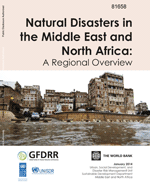 Natural disasters in the Middle East and North Africa: a regional overview
Natural disasters in the Middle East and North Africa: a regional overview
World Bank. January 2014
This report focuses on the challenges of disaster risk in the Middle East and North African (MNA) region. It provides critical feedback to Governments and partners on efforts and processes required to make the region disaster resilient. It focuses on the human impact in the region of both floods and droughts, the consequences and suggested methods of disaster response. The overview analyses in depth the sources of vulnerability to natural hazards in the region, such as water scarcity, increasing climate variability and a fast growing population.
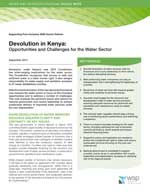 Devolution in Kenya: Opportunities and Challenges for the Water Sector
Devolution in Kenya: Opportunities and Challenges for the Water Sector
World Bank Water and Sanitation Program (WSP). September 2013
Devolution, or the delegation of power by central government to local or regional administration, is by far the most significant initiative in governance that Kenya has undertaken since independence. Under the Constitution of Kenya (2010), devolution has wide-ranging implications for the water sector. The Constitution recognizes that access to safe and sufficient water is a basic human right. It also assigns responsibility for water supply and sanitation provision to 47 newly established counties. Effective implementation of the new devolved framework now requires the water sector to focus on the emerging opportunities and to address a number of challenges. This policy note targets the policy and advocacy audience at national government and county levels involved in the implementation of devolution under the new Constitution. The aim is to identify key transition issues, stimulate debate, and inform decision-making in the water and sanitation sector to achieve sustainable delivery of improved water services under the new dispensation.
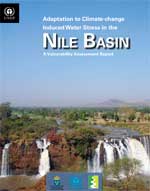 Adaptation to Climate-change Induced Water Stress in the Nile Basin: A Vulnerability Assessment Report
Adaptation to Climate-change Induced Water Stress in the Nile Basin: A Vulnerability Assessment Report
United Nations Environment Programme (UNEP). 2013
This publication presents an overview of the people and places vulnerable to water stress related to the impacts of climate change in the Nile Basin. Satellite and other images provide striking visual evidence of the environmental changes taking place in each of the vulnerable regions identified. Data and information from detailed research provide evidence for the assessment. The report also includes analysis derived from multi-dimensional tools used at various geographic and political levels, from sub-national, national, and sub-basin to the entire Nile Basin area. These include scientific tools, such as scenario analyses and modeling, to improve our understanding of the likely impacts of climate change on the Nile River’s water systems.
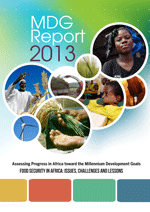 Assessing Progress in Africa toward the Millennium Development Goals. MDG Report 2013. Food security in Africa: Issues, challenges and lessons
Assessing Progress in Africa toward the Millennium Development Goals. MDG Report 2013. Food security in Africa: Issues, challenges and lessons
African Union Commission (AUC), United Nations Economic Commission for Africa (UNECA), African Development Bank (AfDB), United Nations Development
Programme (UNDP). May 2013
As the Millennium Development Goals (MDGs) target date of 2015 approaches, this report takes stock of Africa's progress. This 2013 MDG report reveals a mixed pattern—successes and failures, improvements and challenges, innovations and obstacles. The report summarizes Africa's MDG performance and identifies the best performing countries by indicator. Information about Target 7C: Halve, by 2015, the proportion of the population without sustainable access to safe drinking water and basic sanitation, as well as on factors hindering progress in access to safe drinking water and sanitation is provided. Section III focuses this edition on the issue of food security in Africa, presents the situation and success stories and emerging lessons at country level, including issues related to water supply and irrigation.
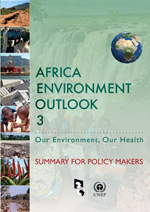 Africa Environment Outlook-3. Our Environment, Our Health. Summary for policy makers
Africa Environment Outlook-3. Our Environment, Our Health. Summary for policy makers
United Nations Environment Programme (UNEP). February 2013
The Africa Environment Outlook (AEO) is a tool of the African Ministerial Conference on the Environment (AMCEN) for monitoring environmental management in Africa. This issue (AEO-3) focuses on the linkages between environment and health. The AEO-3 report begins by highlighting the major drivers of environmental change in Africa and their implications for human health. It also assesses environment and health linkages in the region by focusing on seven priority themes: air quality; biodiversity; chemicals and waste; climate change and variability; coastal and marine resources; freshwater and sanitation; and land. In addition, the report contains a scenario analysis and teases out a series of policy directions. Based on the findings of the thematic assessments and scenario analysis, the report concludes by setting forth transformative policy directions to ensure a sustainable future.
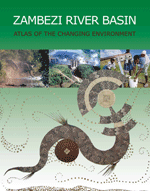 Zambezi River Basin Atlas of the Changing Environment
Zambezi River Basin Atlas of the Changing Environment
Southern African Research and Documentation Centre (SARDC), Southern African Development Community (SADC), Zambezi Watercourse Commission (ZAMCOM), United Nations Environment Programme (UNEP)/GRID-Arendal.
August 2012
The Zambezi River Basin Atlas of the Changing Environment is a basin collaborative initiative with the objective of providing scientific evidence about changes that are taking place in the natural resources and the environment. The Atlas, with climate change as its running theme, is for use by policy makers and other stakeholders, and the general public, to generate action towards climate resilience through adaptation and mitigation of the impacts of climate change. The Atlas discusses the impacts that these changes are having on the basin's people and resources, thus contributing to the documentation and study of the relationship between human populations and the environment.
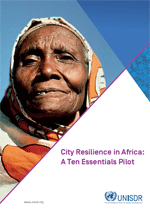 City Resilience in Africa: A Ten Essentials Pilot
City Resilience in Africa: A Ten Essentials Pilot
United Nations International Strategy for Disaster Reduction (UNISDR). December 2012
In 2010, UNISDR launched a global resilient cities Campaign with the specific focus on improving urban cities’ capacity to withstand and recover from natural disasters. By signing up to the Campaign, cities commit to take specific actions to build their resilience. These actions are guided by the “Ten Essentials for Making Cities Resilient”, a 10-point checklist of factors considered fundamental for cities to improve their resilience capacity. In 2012, UNISDR Regional office for Africa in Nairobi, Kenya commenced a pilot project to ‘operationalise’ the Campaign in three cities in Africa – Narok and Kisumu in Kenya and Moshi in Tanzania. This document provides a background to each city and highlights some of the underlying factors that make the three cities vulnerable to hazards, including those related to water.
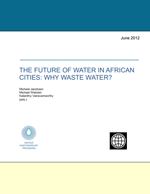 (The) Future of Water in African Cities: Why Waste Water?
(The) Future of Water in African Cities: Why Waste Water?
World Bank Water Partnership Program (WPP). June 2012
This Report provides examples of cities in Africa and beyond that have already implemented Integrated Urban Water Management (IUWM) approaches both in terms of technical and institutional solutions. Case studies explore the ways in which IUWM can help meet future water demand in African cities.
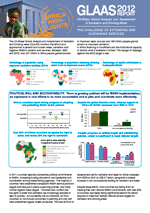 GLAAS Report 2012: Africa Highlights[
GLAAS Report 2012: Africa Highlights[ – 3.9 MB]
– 3.9 MB]
UN-Water, World Health Organization (WHO). April 2012
A document of UN-Water Global Analysis and Assessment of Sanitation and Drinking-Water (GLAAS) which focuses on Africa’s challenge of extending and sustaining services.
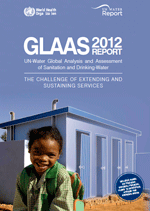 GLAAS Report 2012: UN-Water Global Analysis and Assessment of Sanitation and Drinking-Water
GLAAS Report 2012: UN-Water Global Analysis and Assessment of Sanitation and Drinking-Water
UN-Water, World Health Organization (WHO). April 2012
The objective of the UN-Water Global Analysis and Assessment of Sanitation and Drinking-Water (GLAAS) is to monitor the inputs required to extend and sustain water, sanitation and hygiene (WASH) systems and services. This includes the components of the “enabling environment”: documenting government policy and institutional frameworks; the volume, sources and targeting of investment; the sufficiency of human resources; priorities and gaps with respect to external assistance; and the influence of these factors on performance. A secondary goal is to analyse the factors associated with progress, or lack thereof, in order to identify drivers and bottlenecks, to identify knowledge gaps, to assess strengths and weaknesses, to identify challenges, priorities and successes, and to facilitate benchmarking across countries.
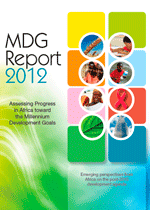 MDG Report 2012: Assessing Progress in Africa toward the Millennium Development Goals. Emerging perspectives from Africa on the post-2015 development agenda[
MDG Report 2012: Assessing Progress in Africa toward the Millennium Development Goals. Emerging perspectives from Africa on the post-2015 development agenda[ – 8 MB]
– 8 MB]
United Nations Development Programme (UNDP). 2012
This document tracks the rate of progress on several MDG-related indicators, including “access to a water source” and “improved sanitation”. The report highlights difficulties hampering progress like lack of political will, pressure on environmental resources to support economic growth, weak governance and planning frameworks, and a lack of financial resources. It also describes emerging perspectives from Africa on the post-2015 development agenda.
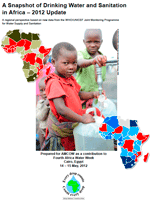 A Snapshot of Drinking Water and Sanitation in Africa – 2012 Update[
A Snapshot of Drinking Water and Sanitation in Africa – 2012 Update[ – 14.3 MB]
– 14.3 MB]
African Ministers’ Council on Water (AMCOW) in collaboration with the WHO/UNICEF Joint Monitoring Programme (JMP) for Water Supply and Sanitation. 2012
This Snapshot of Drinking Water and Sanitation in Africa – 2012 update document, aims to inform senior policy makers about the status and trends in progress towards achieving the MDG drinking-water and sanitation target in Africa. It is a contribution of the African Ministers’ Council on Water (AMCOW) to the fourth African Water Week (Cairo, 15-16 May 2012) which brings together senior officials from across the continent to review and discuss the challenges and priorities in the acceleration of providing access to safe drinking water and basic sanitation. The estimates presented in this document are derived from data collected by national statistics offices and other relevant institutions through national censuses and nationally representative household surveys.
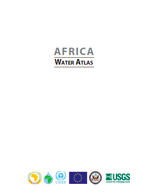 Africa Water Atlas
Africa Water Atlas
United Nations Environment Programme (UNEP). 2010
This Atlas is a visual account of Africa's endowment and use of water resources, revealed through 224 maps and 104 satellite images as well as some 500 graphics and hundreds of photos. However the Atlas is more than a collection of static maps and images accompanied by informative facts and figures: its visual elements illustrate a succinct narrative describing and analyzing Africa's water issues and exemplifying them through the use of case studies. It gathers information about water in Africa and its role in the economy and development, health, food security, transboundary cooperation, capacity building and environmental change into one comprehensive and accessible volume.
Sources:
- Africa Water Atlas. UNEP, 2010.
- Africa Water Vision 2025: Equitable and Sustainable Use of Water for Socioeconomic Development. UNECA, 2009.
- Agriculture at a Crossroads: International Assessment of Agricultural Knowledge, Science and Technology for Development. Global Report. UNDP, UNEP, UNESCO, World Bank, WHO, 2009s.
- Assessing Progress in Africa toward the Millennium Development Goals- MDG Report 2012. UNDP, 2012.
- The Challenge in Disaster Reduction for the Water and Sanitation Sector: improving quality of life by reducing vulnerabilities. UNISDR, 2006.
- The Challenge of Extending and Sustaining Service, GLAAS Report 2012. UN-Water, WHO, 2012.
- The Challenge of Extending and Sustaining and Drinking-Water: Africa Highlights, GLAAS Report 2012. WHO, UN-WATER, 2012.
- Facts and figures from WWDR4. UNESCO, UN-Water, WWAP, March 2012.
- Facts and figures: Water, sanitation and hygiene links to health. WHO, 2012.
- Fact file: 10 facts on Sanitation. WHO, 2011.
- Human Development Reports: Frequently Asked Questions (FAQs) about the Human Development Index (HDI). UNEP, 2011.
- Managing Water under Uncertainty and Risk. The United Nations World Water Development Report 4, Vol. 1. UNESCO, UN-Water, WWAP, March 2012.
- The Millennium Development Goals Report 2010. United Nations, June 2010.
- The Millennium Development Goals Report 2012. United Nations, July 2012.
- Progress on drinking water and sanitation: 2012 update. UNICEF/WHO JMP, March 2012.
- Progress of sanitation and drinking-water: 2010 update. Joint Monitoring Programme (JMP) for Water and Sanitation. WHO/UNICEF JMP, 2010.
- The eThekwini Declaration and AfricaSan Action Plan: 11th African Union Summit on Meeting the Millennium Development Goals on Water and Sanitation. WSP-Africa, 2008.
- (A) snapshot of Drinking Water and Sanitation in Africa. 2012 Update. AMCOW WHO/UNICEF JMP, 2012.
- What are slums and why do they exist? 21st Session of the Governing Council. 16-20 April 2007, Nairobi, Kenya. UN-Habitat, April, 2007.
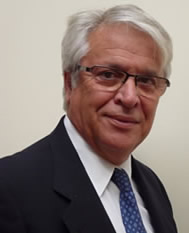
“Africa is the fastest urbanizing continent on the planet and the demand for water and sanitation is outstripping supply in cities”
Joan Clos, Executive Director of UN-HABITAT
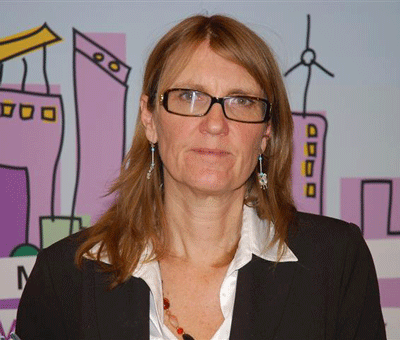
"Many cities and towns throughout Africa are struggling to meet basic urban infrastructural needs such as clean water, waste management disposal and drainage systems"
Helena Molina-Valdes
Director of UNISDR's "Making Cities Resilient" Campaign
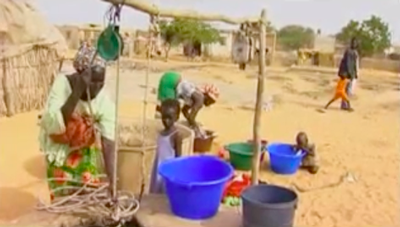 >>Gender Mainstreaming in Water and Sanitation in African Cities
>>Gender Mainstreaming in Water and Sanitation in African Cities
United Nations Human Settlements Programme (UN-Habitat), Gender and Water Alliance (GWA), 2010
Duration: 5min31sec
This video highlights the importance of mainstream gender in the WASH sector in Africa. It introduces the problems women face every day in relation to water and sanitation.
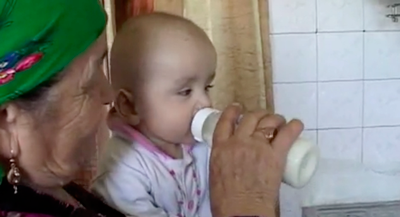 >>Action for Access: Catapulting the sanitation and water sector to meet the MDGs
>>Action for Access: Catapulting the sanitation and water sector to meet the MDGs
World Bank, Water and Sanitation Program (WSP), 2010
Duration: 2mins47sec
This video highlights the present situation of Africa´s water and sanitation sector in trying to meet the MDG target for water and sanitation.
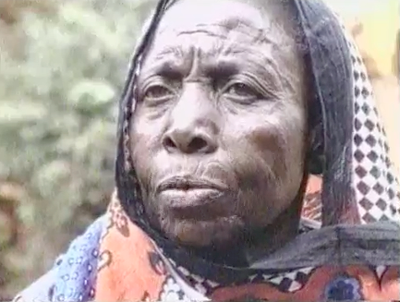 >>Unheard Voices of Poor Urban Women (Water and Sanitation)
>>Unheard Voices of Poor Urban Women (Water and Sanitation)
United Nations Human Settlements Programme (UN-Habitat), 2009
Duration: 9min27sec
This video shows the problems that women in slums around the world encounter in relation to water and sanitation.
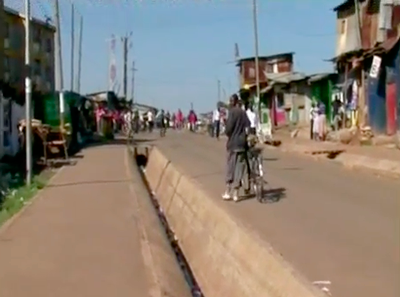 >>Water for African Cities Programme Documentary
>>Water for African Cities Programme Documentary
United Nations Human Settlements Programme (UN-Habitat), 2011
Duration: 25min19sec
This documentary describes the role and activities of UN-Habitat’s Water for African Cities Programme.
- Economic water scarcity. A [human, institutional, and financial capital] kind of water scarcity that limits access to water even though water in nature is available locally to meet human demands.
- Human Development Index (HDI). HDI is a summary measure of human development. It measures the average achievement in a country in three basic dimensions of human development: a long healthy life (health), access to knowledge (education) and a decent standard of living (income).
- Improved drinking water source. Defined as one that by nature of its construction or through active intervention is protected from outside contamination, in particular from contamination with fecal matter. To allow for international comparability of estimates, the MDG indicators considers improved drinking-water sources the following: piped water into dwelling, plot or yard; public tap/standpipe; tube well/borehole; protected dug well; protected spring; rainwater.
- Improved sanitation facility. Defined as one that hygienically separates human excreta from human contact. To allow for international comparability of estimates, JMP considers improved sanitation facilities the following: flush or pour-flush to piped water system, septic tank, and pit latrine; ventilated improved pit latrine; pit latrine with slab; composting toilet.
- Slum. The term “slum” is used to describe a wide range of low-income settlements and poor human living conditions. A simple definition of a slum would be “a heavily populated urban area characterised by substandard housing and squalor”.
Copyright | Terms of use | Privacy notice | Site Index | Fraud alert | Help





